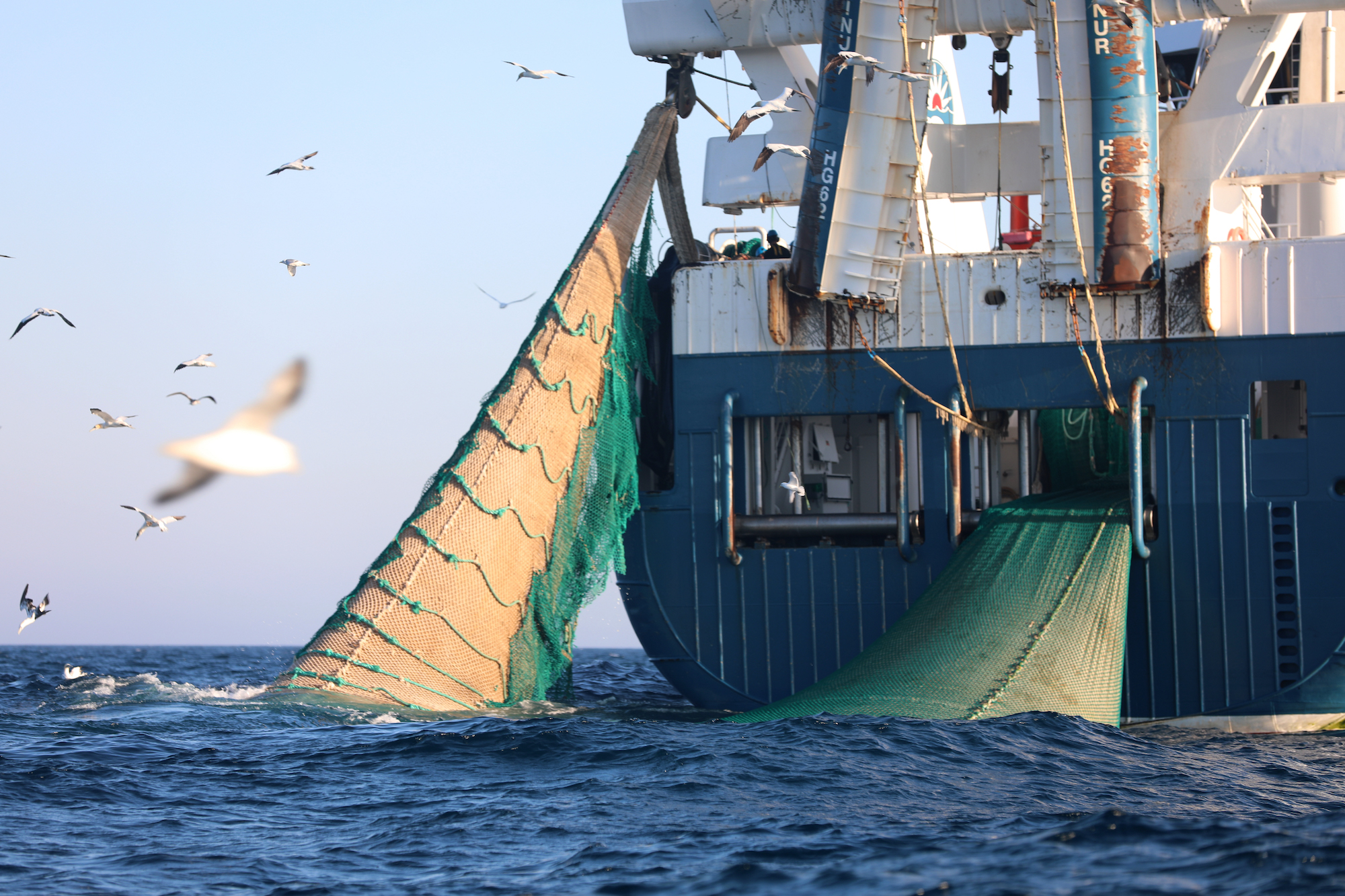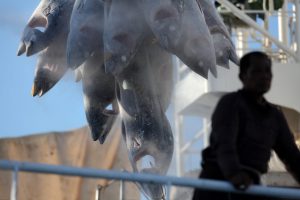An estimated 26 million metric tonnes of fish are lost every year to a cycle of illegal, unreported and unregulated fishing (IUU). This figure reflects a gaping hole in fisheries management: the majority of the ocean and its fisheries remain unmonitored, leaving whole ecosystems vulnerable to collapse.
This is why fishing vessels are increasingly moving under the digital gaze of a growing array of satellites, planes and drones that track their position and behaviour. One growing player in this surveillance space is known as Electronic Monitoring or EM, and involves onboard cameras filming fishing activity.
The system was thrown into the spotlight by the pandemic last year, when it became clear that it could become a powerful potential replacement for human observers on boats, who had to suspend their jobs due to travel restrictions.
Now, EM is at a turning point. “Digitisation is really, really important, in this field in particular,” says Peter Horn, director of the Ending Illegal Fishing Project at the Pew Charitable Trusts.
But what has EM technology achieved so far? Where is it headed next? And does it signal a shift towards total dependence on technology to manage fisheries?
What is Electronic Monitoring?
In its most basic form, EM means onboard cameras recording as crew members fish and haul in catches. The video is then stored on a hard drive for later analysis by fisheries managers ashore. More advanced EM systems include sensors and lasers that detect the motion of fishing gear, triggering the cameras. Captured video can be paired with data from vessel monitoring systems (VMSs), which track boats’ locations via satellites. This way, EM can help produce information not only about the location and movement of the vessel, but also about the species it’s catching.

The EM job has traditionally been fulfilled by human fisheries observers, who can spend months out at sea recording fishing activity in logbooks. In the last 20 years, the digital equivalents have become increasingly attractive.
What information does EM gather?
Cameras, constantly focussed on a vessel’s activities, can provide evidence of illegal fishing. That might include revealing where fishers catch more than their quota; where they bring aboard species that are off limits; where illegal bycatch (fish outside the quota accidentally netted); and where catch discard occur. Cameras may reveal illegal shipments transferred between vessels. Surveillance could also be used to reveal abuses of labour regulations and human rights. Analysis of this extensive video could identify details such as the species composition of a catch and the size of fish hauled aboard, factors that may also help to determine the health of fish populations for conservation purposes.
Why do we need EM?
The challenges of Covid-19 have shown how electronic monitoring can work: fisheries monitoring was too important to the ocean’s health to be stopped. EM provides a way for it to work even when humans can’t.
Even in ordinary times, there are good reasons to embrace EM. Installing cameras on boats is more cost-effective than employing human observers, who require salaries and living costs for months of work at sea. Studies have shown that digital systems can cost between 15% and 50% less than human observers. Camera systems don’t need to sleep. Because they’re constantly on, they can gather round-the-clock information, generating a more comprehensive picture of fishing activity.
By capturing a more or less complete visual record, EM can also reduce the risk of error, bribery and corruption. (Although humans are still required to analyse and report data, so EM doesn’t completely remove such risks.) Because it’s cost-efficient and easy to install, EM could quickly become more widespread on fishing vessels, especially those on remote waters and where human observers are scarce. EM is more likely to move the industry closer to the ultimate goal of 100% fisheries monitoring, compared to human observers who are estimated to currently monitor less than 2% of global fisheries.
Without EM on board, retailers simply cannot say to customers with any level of confidence that seafood products they are selling have been harvested legally, sustainably and without labour abuses
“The reality today is that without EM on board, in many fisheries around the world, suppliers and retailers simply cannot say to customers with any level of confidence that seafood products they are selling have been harvested legally, sustainably and without labour abuses,” says Mark Zimring, director of the Large Scale Fisheries Program at The Nature Conservancy.
How could EM improve fisheries management and conservation?
Over the longer term, EM could build up an extensive record of fisheries data allowing the creation of better informed and more responsive fishing policies. “What I’m excited about is the possibility of highly accurate logbook data, which is essentially what EM can be,” says David Kroodsma, director of research and innovation at Global Fishing Watch. “If we know what a few vessels on the water are catching when they are fishing in a given location, and we can combine this data with vessel movement data, it may be possible to make better models that predict a vessel’s risk of bycatch.” That could translate to protective fishing regulations in some regions. Such expansive datasets could also be used to reliably identify environmentally stable fisheries. That could increase the uptake of eco-labelling, and perhaps encourage appetite for sustainable seafood.
Is there evidence that it works?
Yes, although more studies are needed. One in 2019 showed that captains on Australian vessels retrofitted with cameras reported more discarded catch and interactions with protected species such as seabirds and turtles than those on vessels without the tech, suggesting crew felt more obliged to accurately report their activities.
Meanwhile, recent data from EM trials in Micronesia, Palau and the Marshall Islands showed that video footage from EM-fitted vessels identified significantly higher catch than vessels carrying only a logbook. By helping to form a more realistic picture of what a vessel lands, EM could be a tool to curb overfishing.

How widespread is EM?
Despite the growing evidence base that it works, global uptake has been small. Since the first trial in Canada in 1999, EM has been installed on only about 1,000 boats worldwide, mainly industrial or semi-industrial fleets. But many of these vessels are still only piloting the technology, rather than running permanent programmes. EM is also spread unevenly across the globe: the majority of the systems exist in the United States, which accounts for about 600 boats. Other hotspots are in Peru, New Zealand and Chile. The Nature Conservancy estimates that at the current rate, another 5,000 boats will have EM systems installed in the coming decade. The ongoing effects of Covid-19 may push that total higher still.
Is the use of EM enforced?
There is currently no blanket international legislation requiring vessels to use EM. However, at both regional and national levels, steps are being taken to encourage and enforce its spread. Some of the power to do this may exist with Regional Fisheries Management Organisations (RFMOs). These international organisations are formed of countries with shared fishing interests in particular parts of the ocean, and bound by treaties or agreements. Many RFMOs currently mandate the use of human observers on board vessels. Most also require the use of VMS on vessels that frequent their waters. Many have drawn up programmes to encourage EM use.
Perpetuating the use of surveillance can only be valid if there is a sense of agency over that kind of information.
Businesses in the supply chain, and individual countries, are also playing a growing role, says Zimring. Certain nations are forging ahead with their own regulations. Chile has drawn up legislation to require EM on all its industrial and artisanal vessels by 2022. New Zealand has mandated EM on 20 vessels to test whether it can reduce interactions with dolphins and improve catch reporting. And Denmark now requires that vessels spending more than 20 days at sea carry EM. On the industry side, in May 2020, a coalition of global seafood companies and retailers joined forces to call for fisheries organisations to boost the uptake of EM and replace human observers on fishing vessels. “We’re seeing real momentum with country and industry partners,” Zimring says.
What are the stumbling blocks to uptake?
Increasing EM uptake will be helped by increased enforcement. But there will probably be a greater chance of overall success if fishers embrace it, voluntarily. That will mean addressing some of their concerns about the technology – such as the risk to their privacy of being surveilled at work. This taps into historic mistrust between fishers and fisheries management scientists. There may also be worries over access to the data from the new systems. In some countries those are legitimate concerns, rooted in years of hierarchical fisheries management where powerful nations have carried out stock assessments in lower-income ones, then restricted their access to the data, says Dyhia Belhabib, principal investigator of fisheries at Ecotrust, Canada. To counter this, countries and individual fishers need more involvement and control over the technology and data, if they’re going to embrace it, she says. “Perpetuating the use of a technology and surveillance can only be valid if there is a sense of agency over that kind of information.”
Beyond that, there’s also a cost hurdle to overcome, says Kroodsma: “I think we are a few years away from the cost falling enough to actually be adopted widely.” The solution may be subsidies or payments for set-up costs, which is already happening in New Zealand.
How is EM changing?
Even as EM navigates these challenges, the field is evolving. One important advance is the provision by satellites of high-speed internet on the open ocean. This will eventually enable real-time sharing of the information gathered by EM, to analysts on shore. “This has the potential to alleviate a critical EM pain point – compressing the timeframe between when a fishing event happens and when we have useful information on it,” says Zimring. “Today, we’re generally reliant on waiting until boats come into port and either manually removing hard drives or wirelessly offloading data.”
The other crucial advance is machine-learning and artificial intelligence. Watching months-worth of footage from fishing trips is almost as time consuming as gathering the catch data in person. But now AI systems are being developed to rapidly identify patterns and anomalies in large amounts of video. “Machines help us digest this vast amount of information, and bring it down to something which becomes manageable,” says Horn. To this end, the Nature Conservancy has developed Fishnet.AI, a library of 100,000 tagged fishing images to accelerate machine-learning and develop AI tools. The organisation is also developing the use of facial-recognition technology to identify fish species. This could ultimately help managers to identify illegal catches, or observe how environmental changes may be altering the species composition of a fishery. “I think folks generally see the writing on the wall, that it is ‘when not if’ for EM,” Zimrings says. “The conversation has shifted from ‘this is impossible’ to ‘this is inevitable.’”
Could EM replace humans in fisheries management?
Technology can revolutionise fisheries, yet it can only take us so far. The prospect of replacing all fisheries observers is still a long way off. But even if we wanted to do that, completely removing humans from fisheries monitoring would be impossible, and unwise, experts say. Humans will still be needed to navigate the stickier ethical issues around privacy and data access, or to contextualise the data trends identified by AI, says Belhabib. “I believe that the best AI is going to marry data with human intelligence.” The benefit of this technology also can’t exist without human systems that make it functional. For example, data identifying illegal activity still require legal systems to prosecute and enforce the law, and that’s a system founded on human judgement.

What’s more, when it comes to illegal fishing in particular, technology can only be part of the solution. The other is human-led investigation into why people break the law in the first place. That could boil down to complex societal situations – poverty, criminal networks, even indentured labour – which render technological surveillance irrelevant and instead require a critical human eye.
The field of EM could provide a comprehensive picture of fisheries, uncorrupted by human failures and inaccuracies. AI could make sense of all that data and point the way for better enforcement and conservation measures. Yet there will always be challenges that technology cannot solve, says Belhabib. “Is technology going to save us? Probably. But is technology alone going to save us? Absolutely not.”









